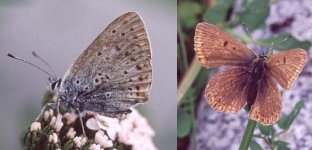Adey Baker
Member
There seem to be several requests for ID at the moment so I'll add another!
A recent thread on CommonBlue/Brown Argus butterfly ID features prompted me to search out these two shots of a butterfly taken on the lower part of the Grossglockner in Austria in July 2000.
Although the butterfly is obviously well worn there ought to be enough features there to pin it down but I can't find anything to match.
It has similarly placed spots on the underside of the hindwing to those mentioned for Brown Argus in that Common Blue/Brown Argus thread but it's clearly not one of those as nothing else really fits that species including the size which was at the large end of the scale for blue butterflies.
The blue 'dusting' on the underside together with the brown upper wings with prominent 'scent' marks and orange and black markings around the edge should be distinctive but I'm obviously missing something here!
Anybody got any ideas?
TAI
Adey
A recent thread on CommonBlue/Brown Argus butterfly ID features prompted me to search out these two shots of a butterfly taken on the lower part of the Grossglockner in Austria in July 2000.
Although the butterfly is obviously well worn there ought to be enough features there to pin it down but I can't find anything to match.
It has similarly placed spots on the underside of the hindwing to those mentioned for Brown Argus in that Common Blue/Brown Argus thread but it's clearly not one of those as nothing else really fits that species including the size which was at the large end of the scale for blue butterflies.
The blue 'dusting' on the underside together with the brown upper wings with prominent 'scent' marks and orange and black markings around the edge should be distinctive but I'm obviously missing something here!
Anybody got any ideas?
TAI
Adey




